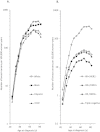Age-specific incidence of breast cancer subtypes: understanding the black-white crossover
- PMID: 22773826
- PMCID: PMC3640371
- DOI: 10.1093/jnci/djs264
Age-specific incidence of breast cancer subtypes: understanding the black-white crossover
Abstract
Background: Breast cancer incidence is higher among black women than white women before age 40 years, but higher among white women than black women after age 40 years (black-white crossover). We used newly available population-based data to examine whether the age-specific incidences of breast cancer subtypes vary by race and ethnicity.
Methods: We classified 91908 invasive breast cancers diagnosed in California between January 1, 2006, and December 31, 2009, by subtype based on tumor expression of estrogen receptor (ER) and progesterone receptor (PR)-together referred to as hormone receptor (HR)-and human epidermal growth factor receptor 2 (HER2). Breast cancer subtypes were classified as ER or PR positive and HER2 negative (HR(+)/HER2(-)), ER or PR positive and HER2 positive (HR(+)/HER2(+)), ER and PR negative and HER2 positive (HR(-)/HER2(+)), and ER, PR, and HER2 negative (triple-negative). We calculated and compared age-specific incidence rates, incidence rate ratios, and 95% confidence intervals by subtype and race (black, white, Hispanic, and Asian). All P values are two-sided.
Results: We did not observe an age-related black-white crossover in incidence for any molecular subtype of breast cancer. Compared with white women, black women had statistically significantly higher rates of triple-negative breast cancer at all ages but statistically significantly lower rates of HR(+)/HER2(-) breast cancers after age 35 years (all P < .05). The age-specific incidence of HR(+)/HER2(+) and HR(-)/HER2(+) subtypes did not vary markedly between white and black women.
Conclusions: The black-white crossover in breast cancer incidence occurs only when all breast cancer subtypes are combined and relates largely to higher rates of triple-negative breast cancers and lower rates of HR(+)/HER2(-) breast cancers in black vs white women.
Figures




Comment in
-
Re: Age-specific incidence of breast cancer subtypes: understanding the Black-White crossover.J Natl Cancer Inst. 2013 Mar 6;105(5):368-70. doi: 10.1093/jnci/djs650. Epub 2013 Jan 25. J Natl Cancer Inst. 2013. PMID: 23355758 No abstract available.
-
Response.J Natl Cancer Inst. 2013 Mar 6;105(5):369-70. doi: 10.1093/jnci/djt002. J Natl Cancer Inst. 2013. PMID: 23586090 Free PMC article. No abstract available.
Similar articles
-
Annual Report to the Nation on the Status of Cancer, 1975-2011, Featuring Incidence of Breast Cancer Subtypes by Race/Ethnicity, Poverty, and State.J Natl Cancer Inst. 2015 Mar 30;107(6):djv048. doi: 10.1093/jnci/djv048. Print 2015 Jun. J Natl Cancer Inst. 2015. PMID: 25825511 Free PMC article.
-
Lifetime risks of specific breast cancer subtypes among women in four racial/ethnic groups.Breast Cancer Res. 2010;12(6):R99. doi: 10.1186/bcr2780. Epub 2010 Nov 19. Breast Cancer Res. 2010. PMID: 21092082 Free PMC article.
-
US incidence of breast cancer subtypes defined by joint hormone receptor and HER2 status.J Natl Cancer Inst. 2014 Apr 28;106(5):dju055. doi: 10.1093/jnci/dju055. J Natl Cancer Inst. 2014. PMID: 24777111 Free PMC article.
-
The influence of socioeconomic disparities on breast cancer tumor biology and prognosis: a review.J Womens Health (Larchmt). 2009 Jun;18(6):883-93. doi: 10.1089/jwh.2008.1127. J Womens Health (Larchmt). 2009. PMID: 19514831 Review.
-
Breast lesions in black women.Pathol Annu. 1989;24 Pt 1:199-218. Pathol Annu. 1989. PMID: 2654837 Review.
Cited by
-
Prospective approach to breast cancer risk prediction in African American women: the black women's health study model.J Clin Oncol. 2015 Mar 20;33(9):1038-44. doi: 10.1200/JCO.2014.57.2750. Epub 2015 Jan 26. J Clin Oncol. 2015. PMID: 25624428 Free PMC article.
-
High-level tumour methylation of BRCA1 and RAD51C is required for homologous recombination deficiency in solid cancers.NAR Cancer. 2024 Jul 25;6(3):zcae033. doi: 10.1093/narcan/zcae033. eCollection 2024 Sep. NAR Cancer. 2024. PMID: 39055334 Free PMC article.
-
Prevalence of Histological Characteristics of Breast Cancer in Rwanda in Relation to Age and Tumor Stages.Horm Cancer. 2020 Oct;11(5-6):240-249. doi: 10.1007/s12672-020-00393-3. Epub 2020 Aug 9. Horm Cancer. 2020. PMID: 32772262 Free PMC article.
-
Differential effects of estrogen-dependent transactivation vs. transrepression by the estrogen receptor on invasiveness of HER2 overexpressing breast cancer cells.Biochem Biophys Res Commun. 2015 Feb 13;457(3):404-11. doi: 10.1016/j.bbrc.2015.01.004. Epub 2015 Jan 9. Biochem Biophys Res Commun. 2015. PMID: 25582774 Free PMC article.
-
Association between Obesity, Race or Ethnicity, and Luminal Subtypes of Breast Cancer.Biomedicines. 2022 Nov 15;10(11):2931. doi: 10.3390/biomedicines10112931. Biomedicines. 2022. PMID: 36428500 Free PMC article.
References
-
- 3.Joslyn SA, Foote ML, Nasseri K, et al. Racial and ethnic disparities in breast cancer rates by age: NAACCR Breast Cancer Project Breast Cancer Res Treat 2005;92(2):97–105 - PubMed
-
- 4.Krieger N. Social class and the black/white crossover in the age-specific incidence of breast cancer: a study linking census-derived data to population-based registry records Am J Epidemiol 1990;131(5):804–814 - PubMed
-
- 5.Parise CA, Bauer KR, Brown MM, et al. Breast cancer subtypes as defined by the estrogen receptor (ER), progesterone receptor (PR), and the human epidermal growth factor receptor 2 (HER2) among women with invasive breast cancer in California, 1999–2004 Breast J. 2009;15(6):593–602 - PubMed
Publication types
MeSH terms
Substances
Grants and funding
LinkOut - more resources
Full Text Sources
Other Literature Sources
Medical
Research Materials
Miscellaneous

